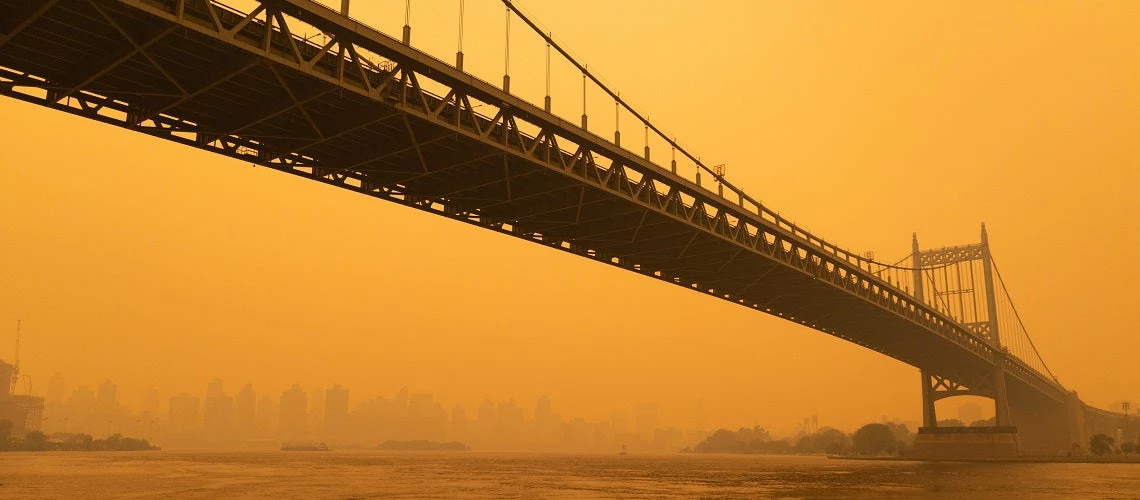 The Triborough Bridge along the East River in New York City with massive air pollution from Canadian wildfires.
The Triborough Bridge along the East River in New York City with massive air pollution from Canadian wildfires.
In early June, the sky turned yellow throughout much of the northeastern United States. People woke up to smog, haze, and a red sun, and were warned to stay indoors to protect themselves from a toxic cocktail of air pollutants. In New York City, the levels of particulate matter with 2.5 microns or less in size (PM2.5) were registered at a record-breaking 400 micrograms per cubic meter. This reading exceeded the U.S. Environmental Protection Agency’s recommended 24-hour standard guidelines 11 times and was equivalent to every person in the city, including babies, smoking 5-10 cigarettes. Such unprecedented levels of air pollution made New York the most polluted of all big cities in the world on that day, displacing perennial record holders like New Delhi or Lahore.
The bad air in New York City and across the Northeast was carried by winds from Alberta, Nova Scotia, and Quebec – Canadian provinces experiencing record-high temperatures and droughts that have caused an unprecedented number of wildfires.
Air quality: A complex web of systems affecting everyone, everywhere
These events underscore that air quality is a complex web of systems affecting everyone, everywhere, to varying degrees. Alarmingly, as of 2021, no country meets the World Health Organization's annual air quality guidelines for ambient PM2.5 – fine air pollution particles, or particulate matter, responsible for 6.4 million deaths every year. Less than 50% of countries meet the less stringent intermediate target. Consequently, 99% of the global population is exposed to air pollution exceeding the recommended WHO limits.
Acute air pollution events caused by wildfires or sand and dust storms are likely to become worse with climate change. There are various reasons why fires can occur, but their growing frequency and intensity points to the intricate connection between climate change-driven extreme weather events and air pollution. In North America, the impacts of El Nino/ENSO that bring drier, warmer weather in the North U.S. and Canada are magnified by climate change. Wildfire seasons have already become longer and more severe. In the U.S., the area burned has dramatically increased from approximately 1.3 million acres in 1983 to over 7.6 million acres in 2020. This trend is not limited to the U.S. and Canada. In recent years, extreme wildfires have ravaged the Amazon, Alaska, Australia, California, Europe, Indonesia, Russia, and Türkiye, spreading pollution across vast distances.
Hotter temperatures and drier conditions due to climate change are not only contributing to more wildfires but also have been linked to increased desertification. Dry and degraded landscapes can intensify sand and dust storms, which together with wildfires carry significant environmental and health risks. Propelled by powerful winds carrying dust particles from erodible soils, particularly in drought-affected and degraded areas, sand and dust storms are intensified by unsustainable land practices, removal of vegetation, and biodiversity loss. They destroy millions of hectares of renewable natural assets and are a significant contributor of air pollution in some parts of the world. Recent studies reveal that over 50% of the annual average PM2.5 exposure in Central Asia and the South Caucasus can be attributed to natural dust and wildfires.
" Hotter temperatures and drier conditions due to climate change are not only contributing to more wildfires but also have been linked to increased desertification. Dry and degraded landscapes can intensify sand and dust storms, which together with wildfires carry significant environmental and health risks."
Air pollution is part of a feedback loop amplifying climate impacts
Air pollution caused by smoke and dust impacts the environment, public health, and productivity. It is part a feedback loop further amplifying climate impacts: wildfires are a major source of GHG emissions and forest destruction, while natural dust storms are associated with soil erosion and loss of soil carbon, as well as lower agricultural yields.
In war-affected Ukraine, forest fires have significantly contributed to increased air pollution-related mortality, with about 8% of PM2.5 emissions attributed to forest fires. In Uzbekistan, a recent study estimates the economic losses caused by sand and dust storms from the dried Aral seabed at $44 million annually. It suggests that carefully planned landscape restoration can significantly reduce air pollution and improve health and livelihoods, providing annual benefits of $28-44 million. It also highlights that landscape restoration can also contribute to climate change mitigation by preventing carbon release and absorbing CO2.
The 2021 wildfires in Türkiye caused extensive damage to urban, forestry, and agricultural infrastructure, impacting residential areas, and resulting in environmental, human, and economic losses. The recently approved $400 million Türkiye Climate Resilient Forests Project aims to address some of these challenges and restore burnt areas. The project will benefit forest villages and communities, providing livelihood and employment support to 21,000 households and financial and technical assistance to 2,000 women-led enterprises. In the Kyrgyz Republic, a $50 million project under preparation aims to address air pollution in the capital city of Bishkek, which many times in recent years ranked first in the world for air pollution by Air Quality Index (AQI). The project will support reduction of PM2.5 pollution through improvement of national air quality management system and measures providing cleaner household heating, a green-belt pilot around the city, and improved maintenance of greenery to reduce windblown dust and heat island effects.
Clearing the air: Why policy action matters
In arid regions like those in Central Asia, the South Caucasus, and Türkiye, and across the globe, comprehensive national green growth strategies and policies combined with sustainable natural resources management and community engagement can significantly reduce air pollution, improve health, and generate employment opportunities at the local level. Effective landscape restoration and soil conservation, urban greening, and fire management can also provide global benefits by mitigating climate impacts and enhancing resilience against future climate-induced shocks.
Ultimately, clean air is a global public good. Its benefits transcend borders, require regional cooperation, and are enjoyed by all. With effective climate, environmental and air quality policy responses, we can ensure that the sky stays blue, not yellow.





Join the Conversation